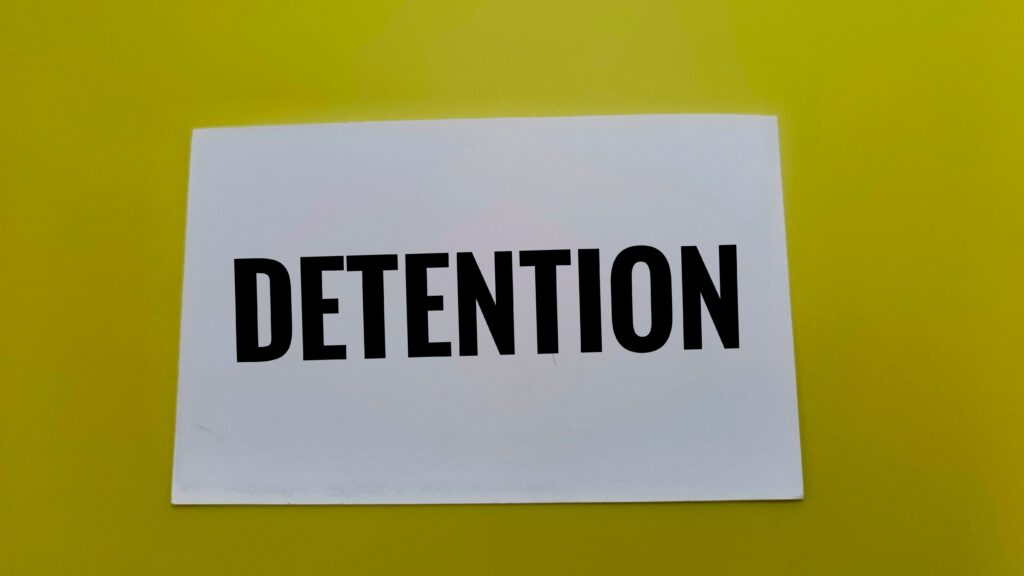When a student acts out, the first instinct for most teachers is to send them to detention. While it seems like a structured, fair consequence, it doesn’t always solve the problem. Detention typically focuses on punishment and usually leaves the underlined issue of why the student is even there unaddressed.
The goal needs to be not just to stop unwanted behavior, but to help the student understand why it happened and how they can make a better choice next time.
Here we’ll take a look at a few strategies that work better than traditional detention. These strategies help improve behavior over time, not just at the moment.
The Problem with Punishment: Rethinking the Role of Consequences
Detention may stop behavior for a short time, but it doesn’t teach students why their actions were wrong or show them how they can better handle themselves next time. The goal should be to ask yourself, “What can the student learn from this?”
When a student sees that you care enough to help them, not just punish them, they will be more likely to take responsibility for their actions and open up to you. You move from being the disciplinarian to their guide or coach.
Core Strategies for Teaching, Not Punishing
Students need opportunities to learn from their mistakes. While detention as a consequence may quiet behavior for a day, it will not teach a student understanding. By using restorative practices and logical consequences, you can help students take ownership of their behavior, which can make lasting changes.
When students understand why their behavior matters and learn how to manage their emotions, they start to make better decisions. That is the kind of learning that extends far beyond school walls.
- Restorative Conversations
Restorative practices like having a conversation with a student, rather than simply punishing them, can be far more powerful than an hour in after-school detention.
- Take a moment to talk with the students one-on-one without their peers around.
- Let them share their side of the story. Sometimes what looks like defiance is actually frustration or embarrassment.
- Stay calm and work together to make a plan on what they can do to make things right.
This simple conversation can help students recognize that their actions affect others and also teach them how to repair relationships when they make a mistake. You’re essentially modeling for students how to stay calm and talk about what happened.
- Logical Consequences that Make Sense
Logical consequences are when the consequences are directly connected to the behavior. These consequences are fair and focus on accountability, which will help the behavior change.
Here are a few examples:
- If a student makes a mess or spills something, they have to clean it up.
- If the student distracts others in the middle of a lesson, they have to help the class refocus or set up for the next lesson.
- If the student damages something in the classroom, they have to fix it or replace it.
When There Is No Logical Consequence
What do you do if there isn’t a logical consequence for the misbehavior? You focus on helping the students understand why they made their choices. This is when you help them to think critically and learn to self-correct.
Ask them:
- What was going on right before this happened?
- How were you feeling at the time?
- How do you think your choice affected others?
- What would you do differently next time?
Sometimes students just need time to reflect and talk through it. Give them this time.
- Cool-Down and Reflective Spaces
Sometimes misbehavior can show up as built-up emotions that need to spill out. Sending students to detention at these moments may make matters worse. Instead, send the students to cool down and reflect.
A calm corner can help students take a few minutes for themselves and just breathe. This can also help students learn to self-regulate their emotions. Over time, they’ll learn to step away on their own.
- The Power of Private Problem Solving
Many students tend to act out because they feel misunderstood or not heard. Calmly talking to them shows you see them, and you care.
Have a private conversation, say something like, “I noticed you are frustrated. Can you tell me what’s going on?” When students feel heard, they will more likely make better choices moving forward.
Preventing Misbehavior Before It Starts
A lot of the time, behavioral issues can be prevented before they ever start. When there’s structure and students feel part of a classroom community, they will feel safe and valued.
Using Positive Behavior Interventions and Supports (PBIS)
PBIS is about preventing problems by teaching expectations. This is where you define and model expected behaviors like kindness and respect.
For example, you may say something like, “I like the way you waited until I was done talking to share,” Or “I appreciate how you helped your group stay on task.” This is when you show students what they did right, so they know to do it again.
Building a Proactive Classroom Culture
- Try greeting students at the door each day. This will help set the tone.
- Don’t assume that students should know better; they may not have been taught what appropriate behavior looks like.
- Try and point out what’s going well. When students know you see them, they will often rise to meet your expectations.
Teaching Self-Regulation
Teaching emotional regulation will help students identify their emotions and manage them before they spill over. Try and integrate a few quick strategies throughout the day, like deep breathing, going outside at the end of the day, and emotion check-in’s like a thumbs up for feeling good and a thumbs down for feeling bad. This will not only give you a sense of how students are doing but also show students that emotions are normal for everyone.
Creating a Culture that Teaches, Not Punishes
Students need opportunities to learn from their mistakes. While detention as a consequence may quiet behavior for a day, it will not teach a student understanding. By using restorative practices and logical consequences, you can help students take ownership of their behavior, which can make lasting changes.
When students understand why their behavior matters and learn how to manage their emotions, they start to make better decisions. That is the kind of learning that extends far beyond school walls.
You’ve got important career goals — we have the graduate program to get you there. Check out our available graduate degree programs to advance your career today!




